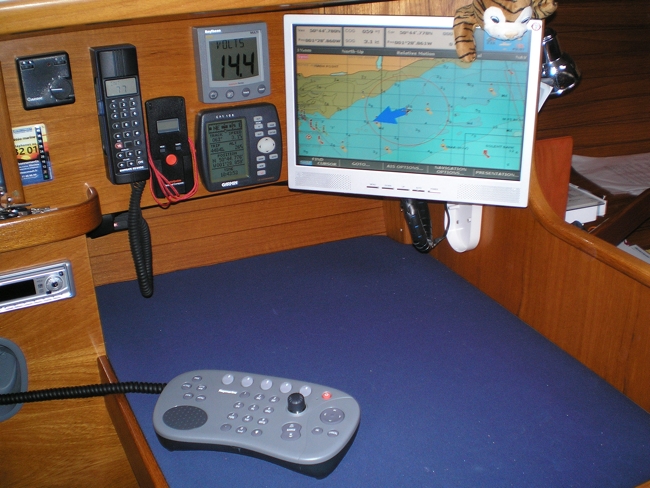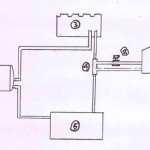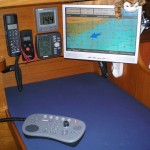Judging by the articles on the MoA website and the Web, it appears generally acknowledged that the Ardic heater which as installed by Nimbus, is less than effective at heating the cabins. We had the heater unit serviced last winter by the local agent and whilst resolved the sooty deposits on the stern, the heating was no better. It appears that in pre heating the engine, heat the fresh water and the cabin is beyond the capabilities of the system unless also running the engine. The basic problem is that the system initially heats the cast iron mass of the engine which I believe takes 3kW, therefore the temperature of the air to the cabin is cool to say the least. The pipework diagram in the manual suggests that this should not be the case, but on a cold day working on the engine with the heating on, the engine was starting heating up but the cabin was not.
Maxi 1100 “Second Rebellion”
Navigation electronics, a cost effective option to having GPS plotters at both the navigation table and at the helm
The 2001 yacht was purchased in August 2008 and it came with a Raymarine RC530 colour plotter at the chart table, a Raytheon RL70 at the helm and a Seatalk interface which integrated the radar. Unfortunately the helm plotter was not readable in daylight, so something had to be done.
- As the yacht had the seatalk interface and all other instruments/radar were Raymarine, we only considered that manufacturer’s equipment.
- We established that the radar scanner would be compatible with the current Raymarine E80 range of plotters and we could also have AIS, however the E80 equipment would not interface with the RC530 existing plotter.
- The obvious but expensive option was to replace both plotters. However, Raymarine in common with other manufacturers, do not market a repeater for the plotter, you just buy 2 of them at around £2k each.
- However with the help of a friendly engineer in the local agent, it was revealed that you did not need a second plotter. An E80 (or E120) at the helm with a VGA cable to an inexpensive LCD computer screen (they are all 12volt), can be used to feed the screen at the chart table linked with a Raymarine keyboard, which they market for the huge screens on power boats. This option is actually better than 2 E80’s, as the PC screen can be larger and as in ours in “letter format”, which is ideal for split screen plotter/data/radar viewing. I believe that the latest “C” series plotters may also have the repeater facility.
- As it happened we had a spare PC screen so it cost us nothing, the screen swivel mount cost about £20 and the quite neat keyboard was £300 plus VAT, quite a saving on £2k and a better option all round.
- All E80 functions can be duplicated below using the keyboard and the PC screen can be swivelled to the saloon to entertain the grandchildren with DVD’s (from a player) with surround sound through the boat audio system.
- The only downside is that manipulating the data from the chart table, also changes the plotter screen at the helm.
- Both old plotters found a ready market on E-Bay, to help offset the cost of the new equipment.
The system has been extensively used for 3 seasons over 5knm without problems and a recent comment from the local agent for Raymarine was “I don’t know why more people don’t go this route”. I do…they just do not know the option is available.
Jim & Eric Sey
Pics:
-
Nav. station, Mount, and Keyboard in use

-
Keyboard parked

News » The future for Najad is secured
Dear customer and sailing friends
It is with great pleasure that we now can welcome our new owner Nord West Yachts, as the final part of giving Najad a long term profitable future.
The last year has been very challenging with many tough decisions and would like to take the opportunity to thank all our employees, board and the former owner Animatrix Capital LLP for big contribution, support and loyalty. The employees has achieved many and big improvements in both sales, quality and production, during the year.
From the day, when the only way forward was bankruptcy, we have been working hard to find the perfect owner of Najad. In Nord West there is good management and excellent craftsmen. Since they are also situated on Orust, I am very sure that the very famous “Orust-quality”, that is wellknown in a Najad, will stay with the Najad brand for many years ahead. I am therefore absolutely sure that Nord West ownership is the perfect harbor for future Najad yachts.
This is now the last part of my assignment to save Najad and it is time for setting sails towards new challenges. Since it, hopefully, will be some more time for sailing next summer, maybe we will meet again out on the ocean.
Until meeting again
Have a nice winter and take good care of your yacht and the love will last forever.
Your sincerely
Mikael Gustavsson
former CEO Najadvarvet AB

